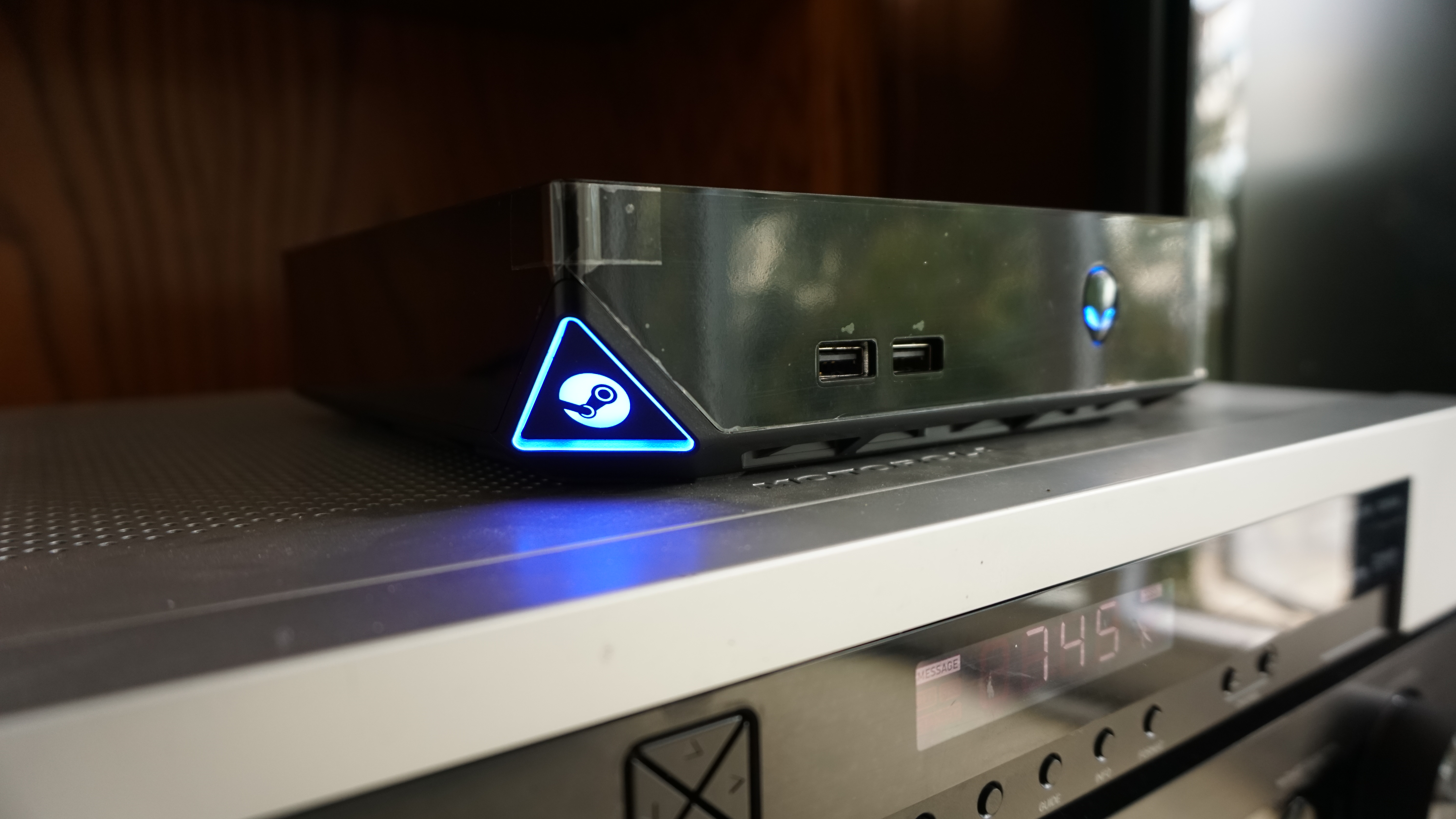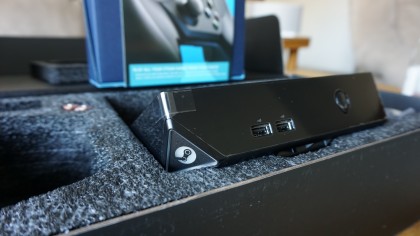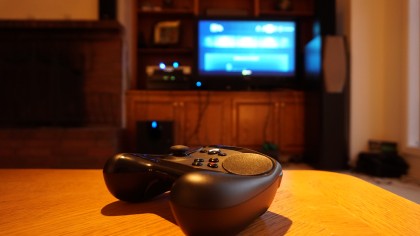
There's a minute, when you first touch a Steam Controller, that something feels wrong. What follows is a sense of dread. "Is this what I've waited for?" you ask.
Typing in your login info requires the use of the two thumb pads that rumble and vibrate as they move over every on-screen letter. Your left thumb takes charge of the left half of the keyboard, while the right thumb takes control of the other. You use the left and right triggers once you've settled on a letter, and use one of the miniature face buttons (A,B,X,Y) to maneuver back and forth between menu screens.
Somehow, the simple act of entering information becomes a miniature brain teaser.
Once you log in, you'll be taken straight into Steam Big Picture Mode. It's nothing new, certainly, but can come as a shock to your system if you've typically started each gaming session in, say, Windows 10.
Your Steam Library will look different, too. Not every game installed on a given computer is compatible with Valve's custom operating system, SteamOS, and its Big Picture Mode. It's confusing, and then a little frustrating. Everything feels weird and different.

I'll admit, the first hour with my new fully functioning Steam Machine – an Alienware Alpha running SteamOS and piloted only using a Steam Controller – wasn't a pleasant one.
But don't stop reading yet. Valve's vision for the future of the living room isn't set in stone. Even though it's different from anything you've ever seen before, it does eventually coalesce to make a sweet symphony of Steam games and home entertainment through movies, music and socialization, both locally and in Valve's online community.
Sign up for breaking news, reviews, opinion, top tech deals, and more.
We're getting ahead of ourselves, however. In order to tell this story of tepid optimism properly, we have to look at all the parts individually – the OS, the PC and the controller itself – before piecing it together into the experience you can expect on November 10, the day the controller releases in GameStop and GAME stores exclusively.
What's SteamOS like?
If you haven't tried SteamOS before (it's been out in a public beta test for the past six months or so), prepare yourself for a full blown crash course in Linux.
While the Alienware Alpha Valve sent me starts up in Steam Big Picture Mode, switching over to the unfamiliar is a click away. Here, the right touchpad controls the mouse cursor and the triggers handle left and right click duties.
Like other Linux builds, SteamOS is pretty spic and span with nary a bloatware app in sight. There are some pre-installed apps – it uses Iceweasel, a web browser forked from Firefox, for instance – but anything more than the bare bone essentials will need to be downloaded.

The only problem I've run into while cruising the Valve's strange, new visage for the gaming PC is that every button on the controller doesn't correspond to an action on the screen. Only the triggers and right thumb pad actually have an effect on what I am doing on the screen. If I have one piece of feedback for the OS, it's that having more shortcuts mapped onto the controller seems like a good place for improvement.
Navigating is still best done with a keyboard and mouse – just because you can use the controller doesn't mean you have to. With plenty of USB ports on the Alienware Alpha, you should be well set on places to plug in.
What's it like using the Alienware Alpha?
I won't spend too much time on the topic, as we already have an excellent review written by one of my fellow editors, Joe Osborne.
But, just as a recap, the Alpha is an excellent value ($549, £449, AU$699) for a very specific demographic. It's console-like quality at more than console-like prices. The hardware allows for several games to be stored on the system at once – far more than the Xbox One or PS4, which basically tap out after seven or eight games on a 500GB hard drive – and I found its performance to more than meet expectations.

Triple-A indie titles looked as great as you might expect given the price. However, while the Alpha can chug through graphic-intensive games, it's nowhere near the same as running them on my $1,000-plus gaming rig sitting in my bedroom.
It's not a seamless transition from game to another, either. There is about a one-minute wait before starting Dying Light and another minute to switch from that to The Binding of Isaac, which became my go-to game when I had any downtime in the last few days.
The takeaway, though, is that performance across the board is good, better than consoles and perhaps even better than you might expect – if you're able to look past the loading screens.
Get to the good stuff! How's the controller?
OK, OK, I'm getting there. The controller is far and away one of the most unique game pads I've ever touched – Ouya controller included. The only feeling I can compare it to is how I imagine people felt after using the N64 controller for the first time after coming from the SNES.
The face buttons, which sport inlaid A,B,X,Y color-coded etchings, are definitely smaller here than they are on both the Xbox 360 or Xbox One controllers and are located to the right of the thumbstick. Similarly, the thumbstick steals the textured rubber finish from the Xbox One's analog sticks and feels exactly like you might expect. The triggers and bumpers are more pad-like than trigger-like, and have an interesting matte finish to them.
There are two additional buttons located under the wings of the controller, and a micro-USB port on the back – which I find particularly odd as the controller runs off AA batteries.

The most noticeable change is the one that's the hardest to overcome: the two massive, haptic feedback touchpads that adorn the left and right wings of the controller. They make sense on a design level and allow for more varied interactions on the screen, but overall they just can't offer the same sort of precision that a stick can – let alone an actual mouse.
But that's not what Valve is going for.
On a recent trip to Valve HQ to test out the controller, I was reminded of Valve's overarching vision. (Since that late-2013 launch, that vision has become obfuscated by the hype surrounding the product, not to mention a slew of delays that has built it up to be the panacea for gaming in the living room.)
Everyone I spoke to, from the engineers to the game designers, even Valve head honcho Gabe Newell himself (who I caught up with at GDC earlier this year), said that the controller is just one solution for gamers looking for a more console-like experience.
You can read the dismissal of criticism in one of two ways: Either A.) The Steam Controller is unwieldy and will perhaps play second fiddle to standard Xbox controllers on its own system or B.) Valve hasn't yet exhausted every possible way to use its own hardware. Personally, I think it's the latter.
Regardless, take this all merely as one editor's first impressions of some truly intricate and evolving hardware.
Wait, what about the games?
There's a sentence you read at the beginning of this piece that might've freaked you out. "Not every game installed on the computer is compatible with SteamOS and its Big Picture Mode."
And while this might not come as a surprise to you, there are certainly some gamers out there who will be let down to know that their 200-plus Steam library might only equate to a few dozen titles on SteamOS. But, as the saying goes, the truth hurts.
Of the 70 games installed on my Steam account, only about 15 are compatible with SteamOS, Alienware Alpha and the Steam Controller. Others required me to stream the game from a nearby PC or, worse, simply stated that they were unavailable. It's tough to determine at this stage if that's something to do with the hardware – Valve doesn't want me to play games on a less-than-optimal PC – or if it's something to do with the OS itself. (Linux has quite a different structure from Windows.)
Whatever the case may be, every title wasn't available, leaving me with only a handful to test out for this piece.
The first was The Binding of Isaac: Rebirth, the 2014 update to the already-excellent 2011 dungeon crawler. Coming from the PC version, I had concerns that a controller would only impede and frustrate me.

I was wrong. Using the left stick to move and either the face buttons (A,B,X,Y) or the right touch pad to fire, I actually enjoy the game more and have progressed further on the Steam Machine than I have on PC.
The other games I played, Dying Light and Team Fortress 2, are a completely different story. The control scheme I picked – yes, you actually pick how you want to control the game, as every game will have a multitude of control schemes depending on your play style – was the one I was most familiar with, i.e. the standard Xbox controller.
While that sounds good on paper, using a touchpad in lieu of an actual stick creates more problems than it solves in a first-person shooter. Navigating hallways becomes a battle of rotating just the right amount. Sometimes, I rotate a hair too far – others, I won't spin far enough. Finding the sweet spot proves difficult, and in the heat of battle between the Blue Team and zombies, the camera is the last thing you want to mess up.
For the time being, I've decided to leave first-person shooter games alone, queueing up more action-adventure games, like Transistor and frenetic multiplayer battler Towerfall Ascension, for the weekend ahead.
Should I be worried?
Not at all. The Steam Machine ecosystem hasn't fully evolved yet, and I don't expect it will for some time. There's a lot of work to do, and Valve isn't one to shy away from doing the right thing for its customers.
So, is Steam Machine's biggest foible right now a software issue or a hardware problem? The answer so far seems like a bit of both.
But maybe I don't like the controls because someone in the community hasn't figured the best ones out yet. (Any player can upload control schemes to the wider Steam community to use.)
Maybe, like has been the case with mods, Steam Greenlight and numerous other ends of the software, it will be the Steam community that will come in and save the day for itself. And while I've given a fair amount of detail here regarding the Alien Alpha and Steam Controller, keep in mind that the software, for the most part, is Big Picture Mode but just with a widely underused, interesting OS underneath it.
I'm optimistic about and see potential for the Steam Machine ecosystem, even if the experience I had with it right out of the box wasn't necessarily the smoothest one.
Valve has promised updates to both the hardware and software in the coming months, which you can count on showing up right here on techradar.

Nick Pino is Managing Editor, TV and AV for TechRadar's sister site, Tom's Guide. Previously, he was the Senior Editor of Home Entertainment at TechRadar, covering TVs, headphones, speakers, video games, VR and streaming devices. He's also written for GamesRadar+, Official Xbox Magazine, PC Gamer and other outlets over the last decade, and he has a degree in computer science he's not using if anyone wants it.